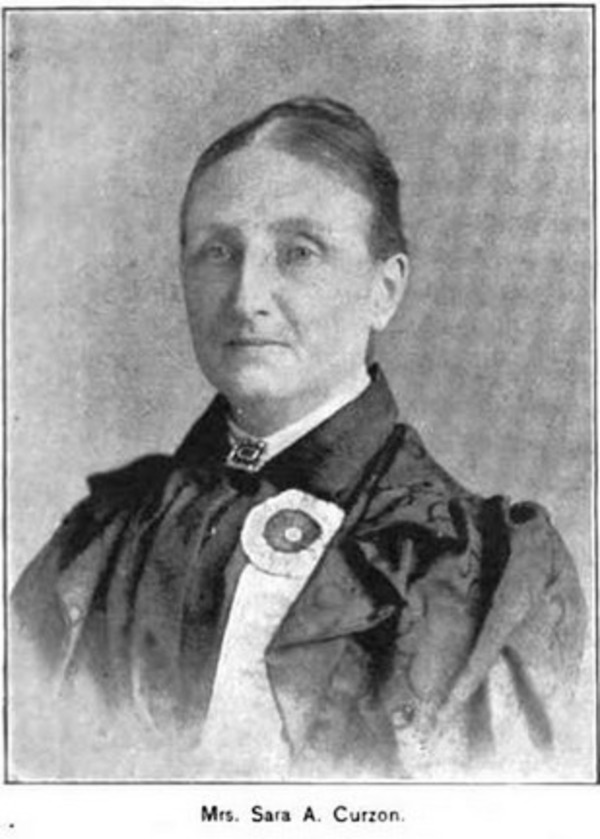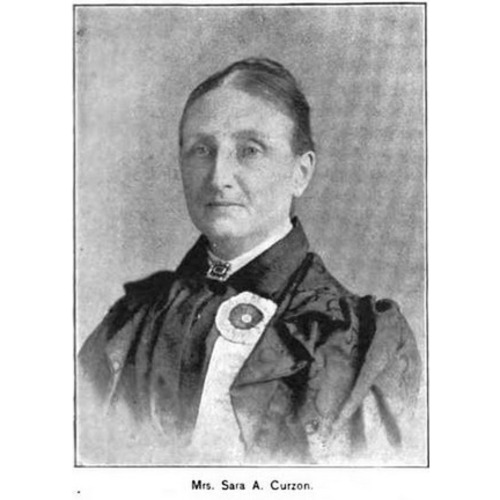
Source: Link
VINCENT, SARAH ANNE (Curzon), journalist, poet, and feminist; b. 1833 in or near Birmingham, England, daughter of George Philips Vincent, a glass manufacturer, and Mary Amelia Jackson; baptized 2 April 1834; d. 6 Nov. 1898 in Toronto.
Sarah Anne Vincent apparently came from a prosperous and intellectual background. Educated by tutors and at a Birmingham girls’ school, she published poetry and short fiction in various English periodicals, among them the popular Leisure Hour (London). She married Robert Curzon of Norfolk in 1858 and in 1862 immigrated with him to Toronto. In Canada she contributed to many periodicals, including the Canadian Monthly and National Review, the Week, Grip, and the Canadian Magazine, all of Toronto, and the Dominion Illustrated of Montreal.
For two years as assistant editor of the Canada Citizen (Toronto), Curzon wrote a column on women’s issues. She spoke out strongly there and elsewhere for women’s rights, including suffrage and the right to attend university. In her short blank-verse comedy “The sweet girl graduate,” written at the request of the editor of Grip, a young woman disguised as a man is admitted to university and graduates as gold medallist, disproving the argument that men are more intelligent than women. Curzon supported the efforts of Dr Emily Howard Stowe [Jennings*] to establish the Woman’s Medical College, founded in Toronto in 1883, and was active in the movement to obtain greater control of their own property for married women.
Having become a strongly nationalistic Canadian, Curzon celebrated in prose and poetry the United Empire Loyalists and the heroes of 1812. The titles of some of her frequent contributions to the Week indicate her viewpoint: “Queenston Heights,” “Imperial Federation,” and “The seventy-fourth anniversary of the battle of Lundy’s Lane.” Her short story “Betty’s choice,” set in Massachusetts in 1783, tells of a young woman who chooses to move to the Niagara area of what is now Canada with the family she serves rather than remain in the United States with the fellow servant who wishes to marry her.
Curzon’s intense patriotism and feminism coalesce in her best-known work, Laura Secord: the heroine of 1812, a blank-verse drama of the 20-mile walk through enemy lines by Laura Secord [Ingersoll*] to warn the British of an impending attack. Curzon notes that she wrote the play in 1876 but lack of interest in Canadian literature prevented its publication until 1887. Well constructed and carefully researched, the play is one of the works that made Laura Secord a household name. It includes a “Memoir of Mrs. Secord” which gives her background and that of her husband. Act 1 presents the discovery of the enemy’s plans and concludes as Mrs Secord leaves on her journey. Act 2 encompasses events along the way, and act 3 takes place in the British camp, ending with the surrender of 500 attacking Americans to the 50 British soldiers with their Indian supporters.
The work reveals Curzon’s feminism. As Mrs Secord sets out on her dangerous trip, leaving her injured husband to worry at home, she says:
Then will you taste a woman’s common lot
In times of strait, while I essay man’s role
Of fierce activity. We will compare
When I return.
In act 2, a scene takes place in the kitchen of Mrs Secord’s sister-in-law in which the family and neighbours argue about whether women are as courageous as men. The conversation provides an opportunity to cite several examples of women’s valour.
In a review of Laura Secord on 20 Oct. 1887, the Week called it “a dramatic poem of much strength” and commented on “the very copious historical notes and appendices at the end of the book [which] testify to Mrs. Curzon’s conscientious researches, and her efforts in providing something for her Canadian public which shall possess a lasting and tangible value.” Later William Douw Lighthall* added his voice in praise of Laura Secord as “a sound true book” and the author as “the loyalist Poetess.”
Curzon was active in Canadian historical organizations. One of them, the Lundy’s Lane Historical Society, published a prose version of Laura Secord. In 1895 she was elected first president of the Women’s Canadian Historical Society of Toronto. In a letter dated 8 May 1896, Charles Mair* wrote to the society’s secretary, Mary Agnes FitzGibbon: “I am also glad to see that my old friend, Mrs. Curzon, is so prominently connected with your society. Few Canadian women have done so much to keep alive the memory of our glorious dead, and she indeed deserves all the honour and distinction which can be conferred upon her by her fellow women.” Curzon was in regular correspondence with the poet and novelist William Kirby* and the historian Sir James MacPherson Le Moine* concerning historical subjects. She was a serious researcher, as evinced in a letter to Kirby by her reference to the long hours she spent in the Public Archives of Canada, reading militia lists and the letters of Major-General Isaac Brock* and others. In the same letter she mentions having met Archibald Lampman and admiring his Among the millet and other poems (Ottawa, 1888). Her correspondence with Kirby also indicates that she had financial difficulties in 1888 and that her husband died in 1894. At the time of her death Curzon was an honorary member of the Lundy’s Lane Historical Association, the York Pioneer and Historical Society, and the Women’s Art Association of Canada.
Sarah Anne Curzon’s Laura Secord, the heroine of 1812: a drama, and other poems was published in Toronto in 1887. “The sweet girl graduate” first appeared in the annual Grip-sack (Toronto), 1 (1882), and was reprinted in Laura Secord. “The battle of Queenston Heights, October 13th, 1812” was published posthumously in Women’s Canadian Hist. Soc. of Toronto, Trans., no.2 (1899): 5–12.
AO, MS 542, A-5, esp. Curzon to Kirby, 21 Nov. 1888, 27 March 1889, October–December 1894; MU 7837–38, esp. MU 7837, Charles Mair to M. A. FitzGibbon, 8 May 1896. Birmingham Reference Library (Birmingham, Eng.), St Philip’s (Birmingham), reg. of baptisms, 2 April 1834. Ont., Office of the Registrar General (Toronto), Deaths, registration no.1898-05-026906. W. D. Lighthall, “Mrs. Curzon’s ‘Laura Secord,’” Week, 24 May 1889: 392. Globe, 8 Nov. 1898. Week, 20 Oct. 1887; 28 June, 2 Aug. 1889; 4 July 1890; 9 Dec. 1892. Canadian men and women of the time (Morgan; 1898). C. C. James, A bibliography of Canadian poetry (English) (Toronto, 1899), 16. Wallace, Macmillan dict. E. A. [Harvey] Currie, The story of Laura Secord, and Canadian reminiscences (Toronto, 1900; repub. St Catharines, Ont., 1913). [Matilda Ridout] Edgar, “Sketch of Mrs. Curzon’s life and work,” Women’s Canadian Hist. Soc. of Toronto, Trans., no.2: 3–4.
Cite This Article
Lorraine McMullen, “VINCENT, SARAH ANNE (Curzon),” in Dictionary of Canadian Biography, vol. 12, University of Toronto/Université Laval, 2003–, accessed March 28, 2025, https://www.biographi.ca/en/bio/vincent_sarah_anne_12E.html.
The citation above shows the format for footnotes and endnotes according to the Chicago manual of style (16th edition). Information to be used in other citation formats:
| Permalink: | https://www.biographi.ca/en/bio/vincent_sarah_anne_12E.html |
| Author of Article: | Lorraine McMullen |
| Title of Article: | VINCENT, SARAH ANNE (Curzon) |
| Publication Name: | Dictionary of Canadian Biography, vol. 12 |
| Publisher: | University of Toronto/Université Laval |
| Year of revision: | 1990 |
| Access Date: | March 28, 2025 |



